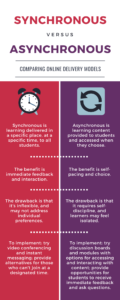Synchronous or Asynchronous Delivery?
Synchronous versus Asynchronous Delivery
You may have been hearing the terms “synchronous” and “asynchronous” used in discussions about online delivery.
Synchronous delivery is learning that is delivered in a specific place, at a specific time, to all students (e.g. students participate in a live Zoom session from 2 p.m. to 3 p.m.). Synchronous delivery provides students with immediate feedback from their teacher and / or fellow learners.
Asynchronous delivery is learning that is provided to students and accessed when they choose (e.g. a posted recording of a lecture that students can watch and post a discussion board comment about). Asynchronous delivery allows students to self-pace their learning and access resources and support as needed.
Algonquin College is recommending asynchronous delivery because both our students and we as faculty may face challenges in attending courses at a particular time, even if it adheres to the previous face-to-face class schedule, due to adjustments in our caregiving and other aspects related to the Covid-19 isolation measures.
If you wish to include synchronous aspects in your course, you are welcome to; however, we suggest that any synchronous component (e.g. a demonstration or lecture via Zoom; virtual office hours) be accompanied by an asynchronous way to receive the same content (e.g. a recording of the lecture; supplemental videos or readings from an external source; ability to book an appointment).
For more information about synchronous and asynchronous delivery, please see the resource content below.
Suggestions to implement asynchronous delivery:
- Discussion boards in Brightspace – divide learners into smaller discussion board groups for more effective interaction.
- Recorded lectures or demonstrations (through Zoom or other recording equipment and software).
- Self-guided lesson modules with options for accessing content, interacting with content, and assessing content.
- Shared whiteboard or posting forum (e.g. through Padlet).
- Blog postings by you and / or your students (e.g. through Brightspace or other tools) or journaling.
Suggestions to implement elements of synchronous delivery:
- Live lectures or demonstrations and chat features through Zoom.
- Shared whiteboard or posting (monitored live) through Padlet.
- Live quiz competitions through Kahoot.
For both methods:
- Communication is key – check in regularly with your learners and monitor their progress. Give them options for how to interact with you.
- Planning will help both you and your students – communicate clear expectations and schedules. Provide enough time for students to engage with learning materials, and consider time that you will need to set aside for providing feedback and support.
- Community is important in an online session – consider ice breakers, online introductions, or “brain break” games to foster a new online community.

Articles that you may wish to review
- Hrastinski, S., 2008. Asynchronous And Synchronous E-Learning. [online] Educause Review. Available at: https://er.educause.edu/articles/2008/11/asynchronous-and-synchronous-elearning [Accessed 19 March 2020].
- Moore, S. and Hodges, C.B., 2020. Practical Advice For Instructors Faced With An Abrupt Move To Online Teaching (Opinion) | Inside Higher Ed. [online] Insidehighered.com. Available at: https://www.insidehighered.com/advice/2020/03/11/practical-advice-instructors-faced-abrupt-move-online-teaching-opinion [Accessed 19 March 2020].
- Lederman, D., 2020. Tips For Injecting The Instructor’s Voice Into Asynchronous Online Courses | Inside Higher Ed. [online] Insidehighered.com. Available at: https://www.insidehighered.com/digital-learning/article/2019/04/17/tips-injecting-instructors-voice-asynchronous-online-courses [Accessed 19 March 2020].
